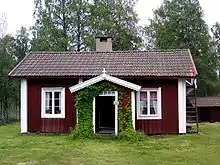Torp (architecture)
A torp (from Old Norse þorp) is, in modern usage, the emblematic Swedish summer house, a small cottage painted Falu red and white, and evidence of the way in which urbanization came quite late to all of Scandinavia. In the meaning of "simple second home", the concept exists under other names in Danish and Norwegian (hytte – but one can also use the term torp in Norwegian) and Finnish (mökki and torppa )

The word is cognate with the Anglo-Saxon thorp or thorpe (a secondary settlement or small group of houses in the countryside), which is found in many English placenames, and its meaning in Swedish has shifted over time. Before the 16th century, a torp was a separate farm,[1] usually established by a farmer who had moved out from a village, and which often grew to become a village in its own right. In 16th century Sweden, which at that time included Finland, a torp was the term for the smallest size of farm, paying a quarter of a "full" farm's taxes. When that classification became obsolete, a torp became a leased farm (with short lease times typically of one or two years), paid for with manual work on the owner's fields.
Since the mid 20th century, most of the surviving torp cottages in Scandinavia have come to serve as summer homes for city dwellers. Before that, being brought up in a torp was a sign of relatively modest ancestry, with lower status than that of lifelong tenants—and very much lower than that of freeholding farmers, however small their farm—although torp dwellers were higher on the social scale than farmhands, maids and those who lived in paupers' cottages (backstugusittare).
In Danish and Norwegian, the common noun for an inhabitant of a torp is husmann/husmand – a man with a house. Such men owned their houses, but no land.
Torp is also used as a surname in Scandinavia.
References
- Johnson, Amandus (1996). The Swedish Settlements on the Delaware, 1638-1664. Genealogical Publishing Com. p. 351. ISBN 9780806301945.
